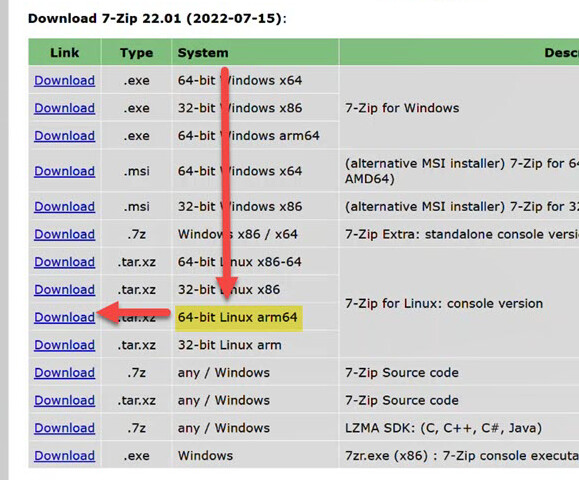In Ui.Vision you can use conditional statements directly in the macro, which makes this web scraping task rather straightforward:
- Loop over each row in the table and extract the value/text from the keyword column using the storeText command. The locator is usually an XPath with numbers inside, which can be obtained by recording a click on a table cell. To make the XPath dynamic, replace the number in the XPath that indicates the row with a variable. For example, change
xpath=//tr[5]/td[3] (recorded by click on table cell)
to
xpath=//tr[${row}]/td[3]
- Next, check the extracted value with an If/then or Do…RepeatIf statement. If it matches the keyword(s), use the found row index (stored in the ${row} variable) in a click or storeText command for the first column.
The video and macro code below explain this process in more detail.
{
"Name": "Extract X-th line of table",
"CreationDate": "2023-5-10",
"Commands": [
{
"Command": "open",
"Target": "https://www.7-zip.org/download.html",
"Value": "",
"Description": ""
},
{
"Command": "store",
"Target": "1",
"Value": "row",
"Description": ""
},
{
"Command": "do",
"Target": "",
"Value": "",
"Description": ""
},
{
"Command": "executeScript_Sandbox",
"Target": "return parseInt(${row})+1;",
"Value": "row",
"Description": "Add 1 to ROW variable | First row in table as HTML index of 2, that is why we start with 2"
},
{
"Command": "storeText",
"Target": "xpath=//tr[${row}]/td[3]",
"Value": "text",
"Description": "Extract text of 3rd column"
},
{
"Command": "echo",
"Target": "${row}th row text=${text}",
"Value": "blue",
"Description": ""
},
{
"Command": "repeatIf",
"Target": "${text} != \"64-bit Linux arm64\"",
"Value": "",
"Description": "Check if we found the right row"
},
{
"Command": "echo",
"Target": "Ok, match at ${row}th row, text=\"${text}\"",
"Value": "green",
"Description": ""
},
{
"Command": "click",
"Target": "xpath=//tr[${row}]/td/a",
"Value": "",
"Description": "Now click the download link in the same row!!!"
}
]
}
Related posts about table parsing:
